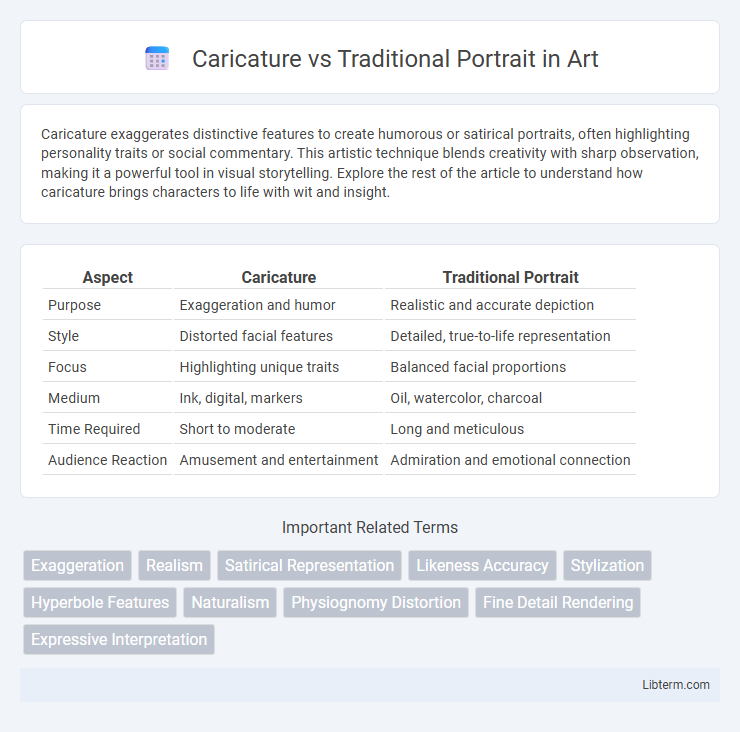Caricature exaggerates distinctive features to create humorous or satirical portraits, often highlighting personality traits or social commentary. This artistic technique blends creativity with sharp observation, making it a powerful tool in visual storytelling. Explore the rest of the article to understand how caricature brings characters to life with wit and insight.
Table of Comparison
| Aspect | Caricature | Traditional Portrait |
|---|---|---|
| Purpose | Exaggeration and humor | Realistic and accurate depiction |
| Style | Distorted facial features | Detailed, true-to-life representation |
| Focus | Highlighting unique traits | Balanced facial proportions |
| Medium | Ink, digital, markers | Oil, watercolor, charcoal |
| Time Required | Short to moderate | Long and meticulous |
| Audience Reaction | Amusement and entertainment | Admiration and emotional connection |
Understanding Caricature and Traditional Portrait
Caricature exaggerates distinctive facial features to capture personality and humor, often emphasizing eyes, nose, or mouth for a playful effect. Traditional portraits strive for realism and accurate representation, highlighting fine details and true likeness to convey the subject's character and status. Both art forms require keen observation and skill but serve different purposes: caricatures entertain and provoke thought, while traditional portraits preserve identity and history.
Historical Origins and Evolution
Caricature originated in the 16th century as artists like Leonardo da Vinci began exaggerating features to critique social figures, while traditional portraiture dates back to ancient civilizations focused on realism and status representation. Over centuries, caricature evolved into a tool for satire and political commentary, whereas traditional portraits maintained an emphasis on idealized likeness and noble aesthetics. Both forms reflect cultural values, with caricatures highlighting personality traits through exaggeration and traditional portraits preserving historical identities with precise detail.
Artistic Techniques Compared
Caricature emphasizes exaggerated features and playful distortion to capture personality through bold lines and simplified shapes, often using vibrant colors and dynamic brushstrokes. Traditional portraiture relies on realistic proportions, subtle shading, and precise details to create lifelike representations with a focus on accurate anatomy and texture. Both styles utilize various mediums, but caricatures prioritize expressive creativity, while traditional portraits aim for faithful depiction.
Purpose and Intent in Both Styles
Caricature emphasizes exaggeration and humor to highlight distinctive features, aiming to evoke amusement or social commentary. Traditional portraits focus on realistic and respectful representation, capturing the true likeness and personality of the subject. The intent of caricatures is often satirical or playful, while traditional portraits seek to preserve dignity and identity.
Visual Elements: Exaggeration vs. Realism
Caricatures emphasize exaggeration by amplifying distinctive facial features, creating a humorous and exaggerated representation that highlights personality traits. Traditional portraits focus on realism, capturing accurate proportions, subtle shading, and true-to-life textures to convey the subject's authentic appearance. Visual elements in caricatures distort reality for expressive effect, whereas traditional portraits strive for precise, lifelike detail.
Popular Uses in Modern Media
Caricatures dominate modern media for their exaggerated humor and satirical impact in editorial cartoons, social media memes, and entertainment shows, capturing attention quickly. Traditional portraits remain essential in formal contexts such as official documentation, museum exhibitions, and personalized gifts, emphasizing realism and heritage. Both forms serve distinct roles, with caricatures enhancing engagement through visual comedy and portraits preserving identity and authenticity.
Emotional Impact on Viewers
Caricatures amplify distinctive features and exaggerate expressions, eliciting strong emotional reactions such as humor or amusement that engage viewers on a playful level. Traditional portraits emphasize realistic representation and subtle emotion, fostering empathy and a deeper personal connection through nuanced facial expressions and detailed gaze. The emotional impact of caricatures often leans towards entertainment and lightheartedness, while traditional portraits evoke introspection and reverence.
Common Subjects and Themes
Caricatures and traditional portraits both often feature prominent individuals such as celebrities, politicians, and family members, highlighting their distinct facial features or personality traits. While traditional portraits emphasize realistic representation and subtle expression, caricatures exaggerate specific attributes like large noses, eyes, or smiles to create humorous or satirical effects. Common themes include identity, social commentary, and character study, but caricatures prioritize bold visual impact, contrasting with the refined detail and naturalistic tones of traditional portraits.
Choosing Between Caricature and Traditional Portrait
Choosing between a caricature and a traditional portrait depends on the desired artistic expression and purpose; caricatures emphasize exaggerated features for humor and personality, while traditional portraits aim for realistic representation and timeless elegance. Caricature suits casual settings, social media, and personalized gifts, capturing distinctive traits with playful distortion. Traditional portraits are ideal for formal occasions, historical documentation, and professional displays, highlighting accuracy and refined detail.
Future Trends in Artistic Portraiture
Future trends in artistic portraiture emphasize the fusion of caricature's exaggerated expressiveness with the nuanced realism of traditional portraits, creating hybrid styles that engage viewers on both emotional and aesthetic levels. Advances in digital technology and artificial intelligence enable artists to experiment with dynamic, interactive portraits that evolve over time or respond to viewer interaction. Increasing demand for personalized and immersive art experiences drives the integration of augmented reality and 3D modeling into portraiture, reshaping how identity and character are visually represented.
Caricature Infographic

 libterm.com
libterm.com